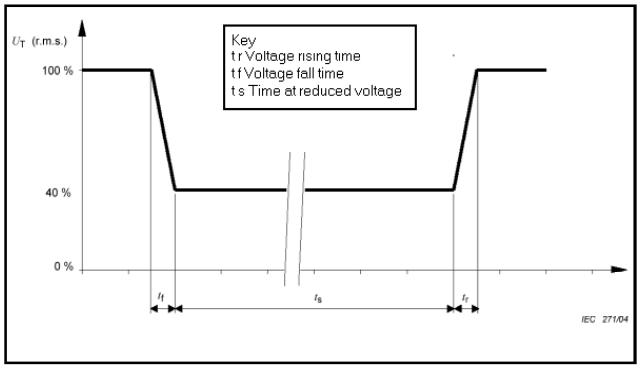Mains voltage dips and short interruptions can be caused by a wide variety of phenomena and can cause equipment to operate unreliability, and in some cases, can damage the equipment. Faulty loads on an adjacent branch circuit, for example, can cause a circuit breaker to trip, and high-power loads such as welders, motors and electric heaters can cause voltage variations. Natural events, such as power lines downed by storms or lightning strikes, may also disrupt mains power.
If the fault is in the power distribution grid, an automatic recovery circuit may cycle open and closed several times within a short period attempting to clear the fault. This will likely result in a sequence of short voltage interruptions as seen by downstream loads.
Voltage variations are typically caused by high power loads that have continuously varying power requirements. These voltage changes can affect the operation of nearby electrical and electronic equipment and sometimes even damage it.
To ensure that products can withstand these interruptions and voltage variations and operate safely and reliably, you must test them under a variety of conditions. IEC 61000-4-11, Electromagnetic Compatibility (EMC) – Part 4-11: Testing and Measurement Techniques – Voltage Dips, Short Interruptions, and Voltage Variations Immunity Tests, aims to standardize the way companies test how their products react to power line variations. Although it is a European standard, manufacturers use it worldwide for design verification testing.
IEC 61000-4-11 was first published in 1994 (Edition 1.0) and amended in 2000. Its scope includes electrical and electronic equipment with an input current rating not greater than 16A per phase. It is one of the required tests in the Generic Residential, Commercial and Light Industrial immunity standard EN50082- 1: 1997 and is also under consideration to be included in the Generic Industrial immunity standard EN50082- 2. It is also included in several product-specific standards such as the EN 61326-1 which went into effect in mid 1999 and covers testing instruments, data acquisition and control systems.
IEC 61000-4-11, edition 2.0, was released in March 2004. Edition 2.0 references IEC 61000-2-8, Environment - Voltage dips and short interruptions on public electric power supply systems with statistical measurement results. It differs from the first edition in the following ways:
- Preferred test values and durations have been added for the different EMC environment classes 1, 2, 3 and user class X.
- The recommended voltage dip and interruption durations are shorter.
- A new test level of 80% of Unom was added for voltage dips test. The 70% test level remains as well, however, and is still used in all product standards.
- Voltage variations are now done using an abrupt voltage change from Unom instead of a voltage sweep. The change from the reduced level back to Unom is still a sweep however.
- All durations for voltage variations are now expressed in no. of cycles of the fundamental AC frequency instead of seconds. The number of cycles for 50 Hz and 60 Hz is chosen so that the time intervals are the same.
- Tests for three phase systems have been specified.
Figures 1 through 3 show timing diagrams for various power disturbances specified by IEC 61000-4-11. Figure 1 shows a 40 % voltage dip. Figure 2 shows a voltage interruption. The duration of either is defined in number of cycles of the fundamental frequency. The actual change in voltage may occur at a set phase angle, e.g. 0° or 90°.
 Figure 1. 40% voltage dip waveform specified by IEC-61000-4-11.
Figure 1. 40% voltage dip waveform specified by IEC-61000-4-11.
 Figure 2. Voltage interruption waveform specified by IEC-61000-4-11.
Figure 2. Voltage interruption waveform specified by IEC-61000-4-11.
Figure 3 shows the timing for a voltage variation. This waveform is different from the voltage variation waveform in edition 1 and better simulates the effects of motor loads starting up on the mains voltage.
 Figure 3. Voltage variation waveform specified by IEC-61000-4-11.
Figure 3. Voltage variation waveform specified by IEC-61000-4-11.
In Part II, we will discuss test levels, the pass/fail criteria for IEC 61000-4-11 testing, and test generator requirements. For more information on IEC 61000-4-11 testing, contact AMETEK Programmable Power by sending an e-mail to sales.ppd@ametek.com or phoning 800-733-5427.




